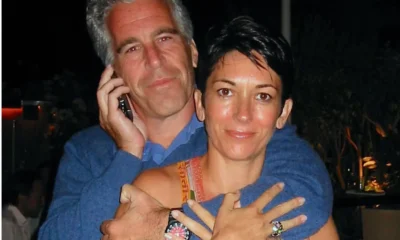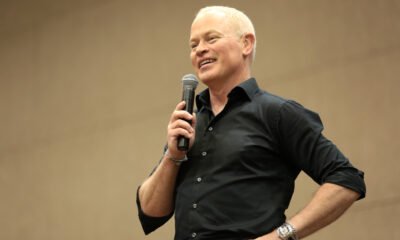Entertainment
Samantha Markle Blasts Meghan In Court: I Can Prove She’s a Liar! on November 9, 2023 at 11:24 pm The Hollywood Gossip

For years now, Samantha Markle has been attempting to make a career out of publicly denigrating her famous sister, Meghan Markle.
She started by bashing the Duchess of Sussex in interviews.
Then, when the news outlets realized that Samantha barely knows Meghan and has nothing of substance to say, the elder Markle churned out a self-serving memoir.
When the book predictably flopped, Samantha switched gears again and started filing frivolous lawsuits against Meghan.
Meghan, Duchess of Sussex speaks onstage at The Archewell Foundation Parentsâ Summit: Mental Wellness in the Digital Age during Project Healthy Minds’ World Mental Health Day Festival 2023 at Hudson Yards on October 10, 2023 in New York City. (Getty Images)
Her latest suit is a desperate attempt to cash in on Meghan’s obnoxious habit of telling the truth about her own life.
Yes, Samantha is suing Meghan for stating that the two of them had few interactions while growing up and have never been close as adults.
Sam is 17 years Meghan’s senior, and the half-sisters had different mothers, factors that, according to Meghan, led to a relationship so distant that it bordered on nonexistent.
Meghan, Duchess of Sussex attends the cycling medal ceremony at the Cycling Track during day six of the Invictus Games Düsseldorf 2023 on September 15, 2023 in Duesseldorf, Germany. (Photo Credit: Getty Images)
Specifically, Samantha claims that Meghan lied about the nature of their relationship during her 2021 Oprah Winfrey interview and in last year’s Netflix docu-series Harry & Meghan.
If you’re feeling like you’re having deja vu reading all of this, that’s because a judge already dismissed Samantha’s defamation suit against Meghan back in March.
But because she has much to gain and nothing to lose (and, of course, nothing better to do), Sam appealed the decision and scored herself a hearing in a federal courtroom in Tampa on Wednesday.
Meghan Markle waves as she leaves with Prince Harry (not seen) after watching a hip hop opera performed by young people involved in the Full Effect programme at the Nottingham Academy school in Nottingham, England. (Photo Credit: Getty Images)
If Sam is successful at this stage, then the case will proceed to trial.
That will amount to a victory for the plaintiff, who will achieve what is almost certainly her real goal in all of this, humiliating her sister with a drawn-out courtroom drama that would necessitate the airing of all their petty family grievances.
(Even Sam likely realizes that she has no chance of winning a case that one judge already laughed off as an attempt to sue Meghan for “expressing an opinion.”)
Being the media hound that she is, Samantha seized the opportunity to talk to the press outside the courtroom this week.
“I think the truth stands on its own, so I’m optimistic and thankful that we have a justice system that gives us the chance to present the facts,” she told UK tabloid The Sun.
Meghan Markle is seen ahead of her visit with Prince Harry to the iconic Titanic Belfast during their trip to Northern Ireland n Belfast, Northern Ireland. (Photo Credit: Getty Images)
Asked if Meghan’s comment about the two of them barely knowing each other was “hurtful,” Samantha made a plea for sympathy.
“Of course it is but you know, people change, they have agendas, they have other things influencing their lives and, you know, it doesn’t change reality,” she said.
“It doesn’t change my heart, I think I’m a lot stronger than that, but it’s sad. I think got to live with that and hopefully some day she can embrace the truth and a better part of herself,” she blathered on.
Prince Harry, Duke of Sussex and Meghan, Duchess of Sussex attend the cycling medal ceremony at the Cycling Track during day six of the Invictus Games Düsseldorf 2023 on September 15, 2023 in Duesseldorf, Germany. (Photo Credit: Getty Images)
“I would want that for her but until then I have to get back a lot of my life that was lost from a lot of damage over several years. All we can do is move forward based on truth and positivity.”
Sam’s efforts to play the victim might be more compelling if this weren’t the same woman who previously accused Meghan of faking her pregnancies and purposefully causing their father to have a stroke.
“This baseless and absurd lawsuit is just a continuation of a pattern of disturbing behavior,” Meghan’s lawyer, Michael Kump, said when Sam initially filed the suit.
Meghan Markle at the Unveiling of the Labalaba Statue in Nadi, Fiji. (Photo Credit: Getty Images)
“We will give it the minimum attention necessary, which is all it deserves.”
Neither Meghan nor her attorney commented on today’s hearing, which will hopefully result in yet another defeat for Samantha.
We’ll have further updates on this developing story as new information becomes available.
Samantha Markle Blasts Meghan In Court: I Can Prove She’s a Liar! was originally published on The Hollywood Gossip.
For years now, Samantha Markle has been attempting to make a career out of publicly denigrating her famous sister, Meghan …
Samantha Markle Blasts Meghan In Court: I Can Prove She’s a Liar! was originally published on The Hollywood Gossip.
The Hollywood Gossip Read More
Entertainment
What We Can Learn Inside 50 Cent’s Explosive Diddy Documentary: 5 Reasons You Should Watch

50 Cent’s new Netflix docuseries about Sean “Diddy” Combs is more than a headline-grabbing exposé; it is a meticulous breakdown of how power, celebrity, and silence can collide in the entertainment industry.
Across its episodes, the series traces Diddy’s rise, the allegations that followed him for years, and the shocking footage and testimonies now forcing a wider cultural reckoning.

1. It Chronicles Diddy’s Rise and Fall – And How Power Warps Reality
The docuseries follows Combs from hitmaker and business icon to a figure facing serious criminal conviction and public disgrace, mapping out decades of influence, branding, and behind-the-scenes behavior. Watching that arc shows how money, fame, and industry relationships can shield someone from scrutiny and delay accountability, even as disturbing accusations accumulate.

2. Never-Before-Seen Footage Shows How Narratives Are Managed
Exclusive footage of Diddy in private settings and in the tense days around his legal troubles reveals how carefully celebrity narratives are shaped, even in crisis.
Viewers can learn to question polished statements and recognize that what looks spontaneous in public is often the result of strategy, damage control, and legal calculation.
3. Survivors’ Stories Highlight Patterns of Abuse and Silence
Interviews with alleged victims, former staff, and industry insiders describe patterns of control, fear, and emotional or physical harm that were long whispered about but rarely aired in this detail. Their stories underline how difficult it is to speak out against a powerful figure, teaching viewers why many survivors delay disclosure and why consistent patterns across multiple accounts matter.
4. 50 Cent’s Approach Shows Storytelling as a Tool for Accountability
As executive producer, 50 Cent uses his reputation and platform to push a project that leans into uncomfortable truths rather than protecting industry relationships. The series demonstrates how documentary storytelling can challenge established power structures, elevate marginalized voices, and pressure institutions to respond when traditional systems have failed.
5. The Cultural Backlash Reveals How Society Handles Celebrity Accountability
Reactions to the doc—ranging from people calling it necessary and brave to others dismissing it as a vendetta or smear campaign—expose how emotionally invested audiences can be in defending or condemning a famous figure. Watching that debate unfold helps viewers see how fandom, nostalgia, and bias influence who is believed, and why conversations about “cancel culture” often mask deeper questions about justice and who is considered too powerful to fall.
Entertainment
South Park’s Christmas Episode Delivers the Antichrist

A new Christmas-themed episode of South Park is scheduled to air with a central plot in which Satan is depicted as preparing for the birth of an Antichrist figure. The premise extends a season-long narrative arc that has involved Satan, Donald Trump, and apocalyptic rhetoric, positioning this holiday episode as a culmination of those storylines rather than a stand‑alone concept.
Episode premise and season context
According to published synopses and entertainment coverage, the episode frames the Antichrist as part of a fictional storyline that blends religious symbolism with commentary on politics, media, and cultural fear. This follows earlier Season 28 episodes that introduced ideas about Trump fathering an Antichrist child and tech billionaire Peter Thiel obsessing over prophecy and end‑times narratives. The Christmas setting is presented as a contrast to the darker themes, reflecting the series’ pattern of pairing holiday imagery with controversial subject matter.
Public and political reactions
Coverage notes that some figures connected to Donald Trump’s political orbit have criticized the season’s portrayal of Trump and his allies, describing the show as relying on shock tactics rather than substantive critique. Commentators highlight that these objections are directed more at the depiction of real political figures and the show’s tone than at the specific theology of the Antichrist storyline.
At the time of reporting, there have not been widely reported, detailed statements from major religious leaders focused solely on this Christmas episode, though religion-focused criticism of South Park in general has a long history.
Media and cultural commentary
Entertainment outlets such as The Hollywood Reporter, Entertainment Weekly, Forbes, Slate, and USA Today describe the Antichrist arc as part of South Park’s ongoing use of Trump-era and tech-world politics as material for satire.
Viewer guidance and content advisory
South Park is rated TV‑MA and is intended for adult audiences due to strong language, explicit themes, and frequent use of religious and political satire. Viewers who are sensitive to depictions of Satan, the Antichrist, or parodies involving real political figures may find this episode particularly objectionable, while others may view it as consistent with the show’s long‑running approach to controversial topics. As with previous episodes, individual responses are likely to vary widely, and the episode is best understood as part of an ongoing satirical series rather than a factual or theological statement.
Entertainment
Sydney Sweeney Finally Confronts the Plastic Surgery Rumors

Sydney Sweeney has decided she is finished watching strangers on the internet treat her face like a forensic project. After years of side‑by‑side screenshots, “then vs now” TikToks, and long comment threads wondering what work she has supposedly had done, the actor is now addressing the plastic surgery rumors directly—and using them to say something larger about how women are looked at in Hollywood and online.

Growing Up on Camera vs. “Before and After” Culture
Sweeney points out that people are often mistaking normal changes for procedures: she grew up on camera, her roles now come with big‑budget glam teams, and her body has shifted as she has trained, aged, and worked nonstop. Yet every new red‑carpet photo gets folded into a narrative that assumes surgeons, not time, are responsible. Rather than walking through a checklist of what is “real,” she emphasizes how bizarre it is that internet detectives comb through pores, noses, and jawlines as if they are owed an explanation for every contour of a woman’s face.
The Real Problem Isn’t Her Face
By speaking up, Sweeney is redirecting the conversation away from her features and toward the culture that obsesses over them.
She argues that the real issue isn’t whether an actress has had work done, but why audiences feel so entitled to dissect her body as public property in the first place.
For her, the constant speculation is less about curiosity and more about control—another way to tell women what they should look like and punish them when they do not fit. In calling out that dynamic, Sweeney isn’t just defending herself; she is forcing fans and followers to ask why tearing apart someone else’s appearance has become such a popular form of entertainment.

 Entertainment2 weeks ago
Entertainment2 weeks agoWicked Sequel Disappoints Fans: Audience Verdict on For Good

 News4 weeks ago
News4 weeks agoYolanda Adams Questions Traditional Views on God’s Gender, Audience Reacts

 Entertainment2 weeks ago
Entertainment2 weeks agoAriana & Cynthia Say They’re in a ‘Non‑Demi Curious, Semi‑Binary’ Relationship… WTF Does That Even Mean?

 News3 weeks ago
News3 weeks agoEpstein Files to Be Declassified After Trump Order

 News4 weeks ago
News4 weeks agoTrump Throws Epstein Files at Clinton’s Door

 Entertainment4 weeks ago
Entertainment4 weeks agoAriana Grande’s Red Carpet: When Fans Forget Boundaries

 Entertainment4 weeks ago
Entertainment4 weeks agoHollywood’s Kiss or Miss Policy: Why Saying No Got Neal McDonough Blackballed

 Entertainment3 weeks ago
Entertainment3 weeks agoJimmy Cliff, Reggae Legend and Star of ‘The Harder They Come,’ Dies at 81


























